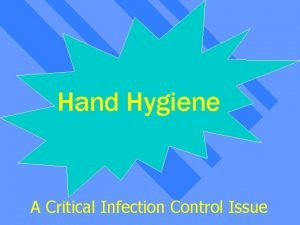Intervention Device for Handwashing Compliance C Flanagan R

- Slides: 1

Intervention Device for Handwashing Compliance C. Flanagan, R. Hrobsky, A. Rieves, B. Rogers Client: Carla J. Alvarado, 1 Department 1 Ph. D of Industrial Engineering, Center for Quality and Productivity Improvement Courses 2 Department of Biomedical Engineering Problem Statement Abstract Hand hygiene • An integral part of health care professional’s job • The single most important infection control procedure Design Constraints • Increase handwashing compliance • Streamline process • Produce an affordable product • Maintain patient/user safety Motivation • 1. 7 million infections • Disinfects user’s hands and maintains cleanliness of keyboard • Handwashing Signal Device • Fits seamlessly into clinical environment • Purell® • Average hand washing compliance is only 48% • Indu. Proof® • Cost-effective • Nozzle orientation covers entire keyboard • Streamlined design • Rapid delivery • Versatile for different disinfectant formulations Testing APIC Guidelines for Handwashing 2 Usability Survey Microbial Testing Keyboard Durability If hand not visibly soiled ; use alcohol-based hand rub • Required after contact with inanimate objects Potential Users' Comfort Level with Device • Inoculated agar plate with subjects’ hand sweat after 10 minutes of wearing gloves Keyboard was submerged in 70% w/w for 48 hours and tested for functionality • Some corrosion observed in plastic • Keyboard still operated Computers On Wheels (COWs) for Patient Records • Clinical staff workstation in patient room • Mobile between rooms • Used on all medical floors • Streamlined design • Password protected • Multiple interventions per patient contact Ethanol for Disinfection • Ethanol vs. Other Disinfectants • UV radiation, ionic silver, iodine • 70% Ethanol > Isopropyl Alcohol • Works against adenovirus • Ideal sanitizer • kill 99. 99% of germs Least Comfortable 4% Less Comfortable 18% Most Comfortable 37% Neutral 15% Comfortable 26% • Isopropyl Palmitate • Subjects used the device and sweat sample was cultured again Evaporation Test • Cultures were kept at 37 ˚C for 48 hours and analyzed 0 0 15 Minutes spent charting per patient visit 2 4 6 8 10 12 -0, 01 Asdsadlfkjasd -0, 02 R 2 = 0, 965 First keystroke initiates spray 10 m. L delivered to keyboard & hands in approx. 3 sec Entering data & attending to patient is hygienic and efficient Future Work Ethanol solution was placed on a scale in various sized dishes and the amount evaporated was measured in mg Evaporation rate as a function of Surface Area Number of interventions per patient 15 Mechanism Log onto computer 4 Patients seen per shift Emollients for User Acceptance • Hands dried for subsequent 10 minutes aporation Rate (mg/min) Hand • Hygiene Components Features Background Spalding Definition for Decontamination 1 Linear actuator drives the production of an atomized spray of disinfectant to the keyboard and the user’s hands • Airtight reservoir – contains disinfectant & prevents evaporation • Linear actuator – automated, runs on DC power to deliver disinfectant by supplying a constant force • 30 cc syringe – plunger component connects to linear actuator piston to deliver constant volume of disinfectant • One-way valves – prevent backflow into reservoir and syringe • Spray nozzle – produces a fine mist of disinfectant onto the keyboard • Circuit – automates device upon predetermined command signal • Safely dispenses disinfectant • Retrofitted • 99, 000 associated deaths • Glycerin Competing Products • Designed for prolonged use Annual Statistics on Hospital-Related Infections • Intermediate-Level Disinfection • Procedure kills vegetative microorganisms, all fungi, and inactivates most viruses Final Design Hospital acquired infections are responsible for approximately 99, 000 deaths per year. Thus, hand hygiene of the clinician is paramount to patient safety. To increase hand washing compliance and reduce the possibility of cross-patient infection, a device was created to interface with electronic medical records entry systems and deliver a dose of disinfectant to both the user’s hands and keyboard. A custom designed pump atomizes an ethanol-based disinfectant onto the user’s hands and keyboard upon a pre-determined command signal. In order to evaluate the effectiveness of the system several tests were performed. A microbial culture test verified that the delivery system was effective for sufficient disinfection. Also, a keyboard durability test confirmed that a keyboard does not lose its functionality even after a 48 hour exposure to concentrated ethanol. Finally, a questionnaire was given to 29 nurses at UW-Hospital. The surveys indicated that 76% of nurses would support the implementation of this design. In the future further testing will be done on the formulation of the disinfectant, as well as more efficient ways to effect atomization. Project Goals • Vitamin E Advisor: Brenda Ogle, 2 Ph. D 14 Technology Develop shield to focus spray range Generalize attachment for different WOW designs Optimize reservoir Translation Test different disinfectant formulations Adapt design for easy commercial assembly Long-term usage testing in clinical setting -0, 03 References -0, 04 -0, 05 1. 2. 3. 4. -0, 06 -0, 07 Surface Area (in 2) 5. 6. 7. 8. Spalding Definition. http: //www. co. dare. nc. us/depts/EMS/Bloodborne/page 23. htm APIC Guidelines. http: //www. guideline. gov/summary. aspx? ss=15&doc_id=3484 Ethanol and Emollients. http: //www. cdc. gov/mmwr/preview/mmwrhtml/rr 5116 a 1. htm Hand Hygiene Statistics. Bischoff, W. E. et al. “Handwashing compliance by health care workers: The impact of introducing an accessible, alcohol-based hand antiseptic. ” Arch Intern Med. 2000 April; 10 (160): 1017 -1021. Indukey. http: //www. indukey. com/content/featured_prod. html Purell. http: //www. pfizerch. com/brand. aspx? id=310 Handwashing Signal Device. www. handwashinghelp. com Hospital-Related Infection Statistics. Klevens, R. Monina et al. “Estimated Health care-Associated Infections and Deaths in US Hospitals, 2002. ” Public Health Reports. 2007 March; 122: 60 -66.

